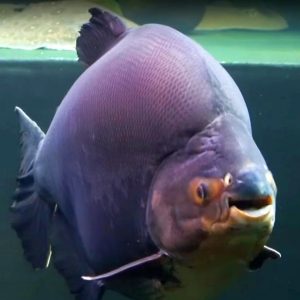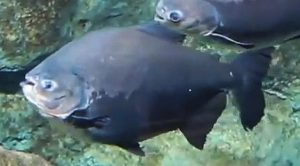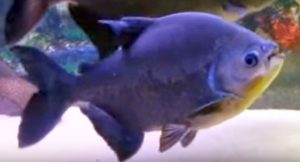The Black Pacu (Colossoma macropomum) also known to tropical fish keeping enthusiasts as the Tambaqui, Blackfinned Colossoma, Giant Pacu, Cachama, and Gamitana Blackfinned Pacu is native to the Amazon and Orinoco River basins in South America.
The Black Pacu is a close relative to the Red Bellied Pacu (Piaractus brachypomus) and is the largest characin in the family that in it’s native environment can grow to a length of 4 1/2 feet or more.
Because of their enormous size and tasty flesh the Black Pacu is an important local food source that has been introduced into New Guinea, Bolivia, Peru, Colombia, Brazil, Venezuela, Cuba, Jamaica, Honduras, Panama, and even accidently into the lakes and canals of the warmer areas of the southern United States.
Because the seeds from the fruit and nuts that they eat pass undamaged through their digestive systems and are spread into other areas of their range as they migrate, Black Pacu fill an important niche in the ecological systems of their native habitats.
Black Pacu are a peaceful, solitary, shoaling species that as juveniles live in the slower moving tannin stained black waters of the flood plains, feeding on small fish, insects, snails, zooplankton, and decaying plant matter.
As they become adults, Black Pacu become more solitary and during the initial months of the flood season will move into the flooded forests to feed on the newly accessible fruits, nuts, and seeds
that drop into the water column.
Except for their dentils, juvenile Black Pacu (Colossoma macropomum) are often confused with juvenile Piranha which look almost identical.
Unlike Piranha which have sharp serrated cutting teeth, the dental structure of the Black Pacu resembles those of human molars, but the easiest way to tell juveniles apart without opening their mouth is to look at the jaw of the fish.
The lower jaw of a Piranha juts out well past the upper lip, whereas the jaw of a Pacu does not.
Black Pacu have a laterally compressed, gray to black body, with spots along the midsection and black fins.
The body of an adult Pacu is very deep and has a slight arch on the back.
Males have a sharper extension on their dorsal fin, a toothed anal fin, and are more brightly colored than the females. Females are more rounded than males when viewed from the top.
Black Pacu are very hardy, can tolerate a wide range of water conditions, and are disease resistant, which makes them relatively easy to care for however, they require plenty of free swimming space.
Because they expel copious amounts of waste, they need frequent 30 to 50% bi-weekly water changes and a very large external biological filtration system or large pond filter to keep them healthy.
Unless you are an advanced tropical fish keeping enthusiast with substantial means, they are best housed in commercial aquariums or heated ponds. However, other than their need for space, they are relatively easy to care for.
A huge tank of 600 to 1,000 gallons or more is required to keep Black Pacu in a community setting. Housing them with small fish should be avoided, but larger slow moving species like Arowana, large Pimelodid, Loricariids, or Doradids catfish, large cichlids, or other large characins can be considered as tankmates in a community environment.
Pea gravel, river rocks, and water worn boulders can be used as a substrate along with a few large pieces of driftwoodor bogwood for decor, however, live plants will be immediately eaten.
Black Pacu have not been known to breed in an aquarium environment. They are commercially bred in food fisheries through the use of hormones.
Black Pacus are omnivores that in their natural habitat consume fruits, grains, insects, snails, worms, detritus, and plant matter. In an aquarium environment, they will readily eat most anything that they can fit into their mouths. A pellet or Spirulina diet augmented with fresh and frozen vegetables will keep them healthy and happy. They will eat lettuce, spinach, apples, peaches, grapes, bananas, peas, carrots, cabbage, and just about any vegetable matter you can come across with gusto.
Black Pacu (Colossoma macropomum) are readily available in tropical fish keeping shops as juveniles, usually mixed in with Red Bellied Pacus, Silver Dollars, Piranha, etc. They are also available online and from auction sites at reasonable prices.
Remember that juveniles grow into adults quickly, so be prepared to upsize your tanks accordingly.
Minimum Tank Size: 600+ gallons
Care Level: Moderate
Temperament: Peaceful
Aquarium Hardiness: Very Hardy
Water Conditions: 74.0 to 82.0° F, 2 – 15 dGH, pH 5.0-7.8
Max. Size: 42.5″
Color Form: Gray, Black
Diet: Omnivorous (primarily Herbivorous)
Compatibility: Aggressive to small fish
Origin: Amazon and Orinoco River basisns
Family: Characidae (Serrasalmidae)
Life Span: 25 years or more
Aquarist Experience Level: Advanced





